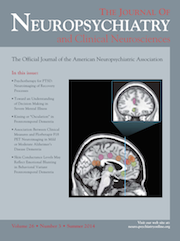To the Editor: Peduncular hallucinosis (PH) is characterized, by among other symptoms, vivid, visual hallucinations (VH) that typically present in the initial days following an acute insult (i.e., vascular) to the pons, midbrain, cerebral peduncles, and/or thalamus.
1 We present, with enthusiasm, a patient who developed symptoms consistent with PH status postthalamic/cerebral peduncle cerebrovascular accident.
Case Report
Our patient was a 40-year-old black woman admitted for a 1-week history of VH of colorful animals. She reports the VH lasting about 2–3 hours/day, occurring usually nocturnally but not associated with sleeping and had insight into the nature of the VH. While reporting difficulty with sleep continuity, she denied hyper-somnolence. Past psychiatric history and substance abuse history were noncontributory (urine drug screen was negative). Mental status exam was unremarkable and Mini-Mental State Examination (MMSE) score was 29. Patient’s vital signs were stable and physical examination was notable only for right eye proptosis but no change in pupillary size/other ophthalmoplegias. Metabolic and infectious evaluation was unremarkable. MRI of the head showed a signal abnormality, felt to be vascular in origin, throughout right thalami and right cerebral peduncles. Our patient began risperidone, ultimately titrated to 1 mg b.i.d.; 7 days later, VH resolved.
The hallmarks of PH are vivid and stereotyped VHs and can include fragmented sleep, hypersomnia during the day, and oculomotor abnormalities. VH usually start within a few days of the initial insult and resolve within a few weeks, but they may last for years. Each hallucination may last from minutes to hours, often occurring in the evening. Patients often have insight into their hallucinations.
1One proposed mechanism of PH is the loss of brainstem input to the regions of the thalamus involved in suppression of the visual cortices (occipital and parts of the temporal lobe) resulting in a release phenomenon. That is, dysregulation of the inhibitory control of the ponto (vis-a-vis serotonergic disinhibition)-geniculate (vis-a-vis unopposed excitatory cholinergic activity)-occipital system leading to VH.
2Interestingly, our patient presented with proptosis without other ocular findings. Protoptosis has been described to occur with oculomotor nerve lesions.
3 The oculomotor nerve traverses thru tegmentum and substantia nigra, ultimately emerging on the medial aspect of the cerebral peductal,
4 which can account for our patient’s proptosis, given her cerebral peduncle lesion.
Multiple psychotropic medications can be helpful in the treatment of VH, include atypical antipsychotics. The latter medications share serotonin (5-HT) type 2/dopamine (D) type 2 receptor antagonism. If VH in PH occurs through “disinhibited” serotonergic transmission, then risperidone’s 5-HT antagonism could explain its efficacy in our patient. Further evidence of this theory is supported by a report, that at least in Parkinson’s Disease, VH may be related to increased 5-HT2A receptors within the ventral visual processing pathway.
5 Alternatively, VH from PH can resolve spontaneously, although, as mentioned above, this usually occurs over weeks,
1 as opposed to our patient, when VH resolved by 1 week.
In summary, although rare, acute onset of VH should prompt the examiner to consider PH in its differential diagnosis.

